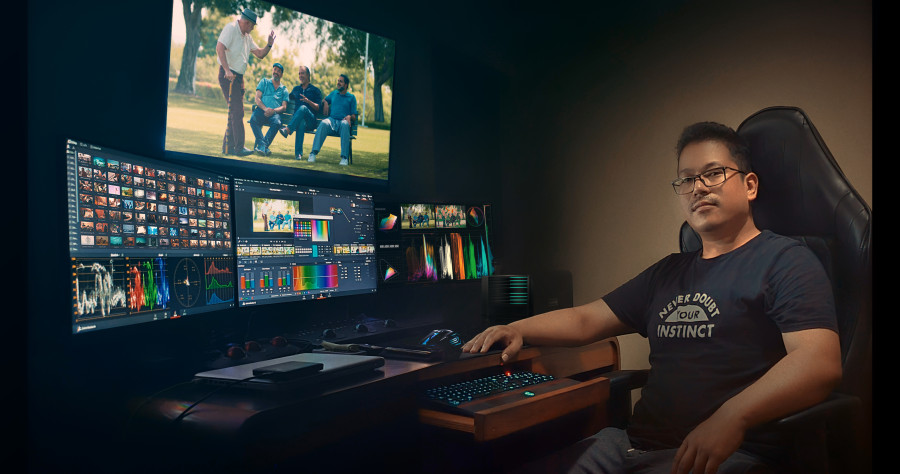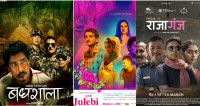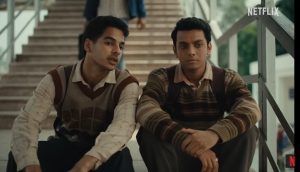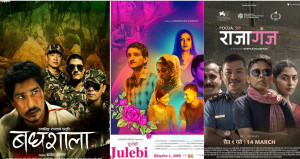Movies
Rajendra Moktan: Colours are powerful, and they can make us feel many things
A celebrated colourist on the significance of colours in films and how the Nepali film industry perceives his job.
Ankit Khadgi
When colourist Rajendra Moktan started his career in 2011, Nepal lacked trained colourists and even institutes that taught this craft.
"We didn't have the technology or the necessary resources that could help us learn about colours and the art of colour grading. Another challenge we faced back then was filmmakers weren't interested in using colours in their films to elevate the viewing experience for the audiences," says Moktan.
But after a decade of working as a colourist in more than four dozen films, which includes 'Uma', 'Saanghuro', 'Dreams', 'Bulbul', 'Lalpurja', Moktan believes that things have changed for the better. Filmmakers these days are receptive to the impact of colours, understanding the effects of colour grading on story-telling.
In this interview with the Post's Ankit Khadgi, Moktan explains what colourists like him do, the importance of colours in films, and the challenges colourists face in a movie industry like ours. Excerpts:
A lot of people are unaware of what colourists do? Could you describe what the job of a colourist is in a film?
Colourists are those who play with colours and manipulate them in films. They work closely with filmmakers and the director of photography (DOP) to help the film achieve a specific mood and style by using colours in the scenes. From making a shot look stunning to giving a distinct visual style to a movie, colourists help the director achieve their vision.
Depending on how the director wants a particular scene to look and feel, the colourist highlights specific colours that reflect the mood of the story and what the characters of the film are feeling at that moment.
So, simply put, a colourist's job is to help the director achieve their vision by manipulating various colours on the screen.
When did you decide to become a colourist? What aspect of the profession attracted you to it?
Since my childhood, I have always been interested in working in the media. I started my career as a technician, working in various technical departments of movies. In the beginning, I wanted to be a film editor. But when digital filmmaking took over the whole world, I came to know about colour grading. I was so fascinated with the process and art of colour grading that I spent a year learning about it. Another reason that interested me in pursuing the colourist profession was that there was a scarcity of competent colourists here in Nepal. This made me realise that there was immense scope for growth.
In 2011, I started working as a professional colourist. My first project was a film called 'Apabaad', in which I was the assistant colourist.
What were the challenges you had to face when you started?
When I first started, there were no colour grading courses for interested people. The computers and softwares available at the time were also too expensive, beyond many people's reach. Neither did we have the technology nor other resources to guide us to learn about colours and the art of colour grading. Such was the environment in which I began my journey as a colourist.
When I finally started working, one of the biggest challenges I had to face was convincing Nepali filmmakers of the value of hiring a colourist. Many didn't understand the importance of hiring an expert who could manipulate colours and enhance their films.
Another issue in those days was that many filmmakers were obsessed with the idea of using bright, glossy colours in their films as they wanted their actors to look fair and shiny.
We have come a long way since, and things are much better today. Many filmmakers now understand the importance of colour detailing and put a lot of focus on it. They prefer to closely work with a colourist, guiding them to pick the best colour that depicts the mood of the scenes and the emotions that characters are going through in the story. Filmmakers today are aware of the vital role of colourists in filmmaking.
The pandemic has dealt a massive blow to the movie industry, and there aren't many new movies being made. How are you keeping yourself busy, and are you colour grading/correcting any exciting projects?
As a professional, I don't only work in movies. I have worked as a colourist in music videos, public service announcements (PSAs), web series, short films, and documentaries.
So, yes, regardless of no new movies releasing, I am busy with a few projects at the moment.
That said, the pandemic has undoubtedly affected my craft. I lost an opportunity to work in an international web series because I couldn't set aside time for the project because the pandemic brought along many challenges that needed my attention.
You have worked in more than four dozen Nepali films. What have you learned from your experience?
As a colourist, I still believe I have a lot to learn as colour grading as an art form is constantly evolving. But I have definitely been able to learn how the significance of colour is deeply embedded in our traditions, which are directly translated to the screen.
Every colour has a symbolic meaning. Likewise, there's also a science behind why certain colours are used for specific objects. From the yellow school bus to the soldiers’ uniform, there's a purpose behind using those colours. Working in this profession has made me realise the power of colours, the value behind using particular colours, and how this knowledge can be used to make story-telling more impactful.
Explain your working process. How closely do you work with directors and cinematographers?
Well, my working style differs from film to film. In some projects, I get involved from the post-production stage, and in some, filmmakers ask me for my input in the pre-production phase, which is when we discuss the mood board and the film's visual style.
I am usually a person who prefers to interact closely with directors and cinematographers. Once we conduct a screen test in a hall for movies or on television for series, I even do retouches if needed.
It's a common practice in the Nepali movie industry for an editor to also work as a colourist. How does this impact a film?
I don't think there's anything wrong with that. If an editor is well versed in colour grading and knows what colours to use and when, they can work as a colourist. However, I believe experts should lead these two departments in their respective fields.
If a separate colourist is hired, they can solely focus on colours and only colours. So, it's always better to have separate professionals lead the areas.
Are there any international films with great colour grading that you would like to recommend to those who want to know more about the art form?
I love the colours used in 'Joker' (2019). 'The Grand Budapest Hotel' (2014), 'In the Mood for Love' (2000), 'Her' (2013), 'Saawariya' (2007), and 'The Last Emperor' (1987).




 19.12°C Kathmandu
19.12°C Kathmandu














